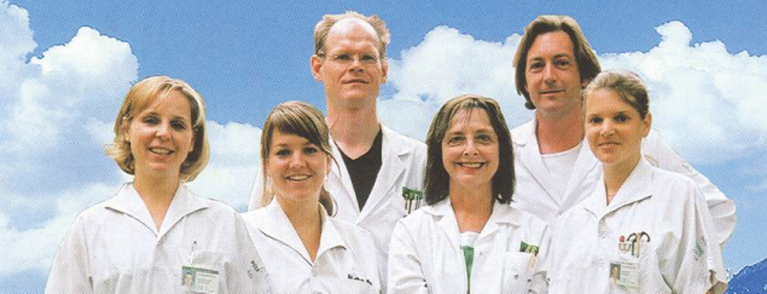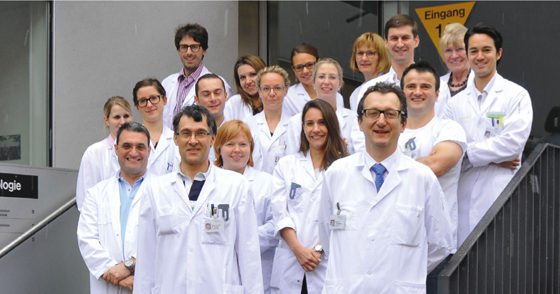The Clinic for Dermatology/Allergology at the Cantonal Hospital in St. Gallen has been in existence since 2004. Meanwhile, dermatology was almost bursting at the seams, but today it is a byword for well-organized, multidisciplinary therapy and research. The lifting of the admission freeze with all its consequences did not stop at St. Gallen.
The skin is our business… However, it was hardly imaginable a month before the opening that the former kindergarten could become a clinic. In retrospect, it is also hard to imagine that a large hospital like the Cantonal Hospital of St. Gallen had previously managed without dermatologists: all the more so as we had to treat the first case of toxic epidermal necrolysis (TEN) on only the fourth day after opening. In the meantime, the initial team of six with two physicians has developed into a 25-person clinic with seven physicians. The number of consultations has increased from 5000 per year to 16,000. Dermatosurgery has been expanded, as well as the laser center and a center for clinical studies, for the clarification of all allergies and dermatoses including. Mucous membranes, hair, nails. Today, the portfolio of the Clinic for Dermatology/Allergology at the Cantonal Hospital St. Gallen also includes the consultation service for the hospital and the region and the assessment of inflammatory dermatoses (histopathology), smears, etc. on the microscope.
Multidisciplinary to the goal
The basic idea of the management with the then CEO Hans Leuenberger and today’s CEA Daniel Germann was to offer a networked interdisciplinary medicine in which synergies are used and thus the necessary specialists are available for every illness – regardless of where the referral was made. This resulted in multidisciplinary boards for autoimmune diseases and tumors and a lively collaboration with nephrologists for organ transplant patients, with gastoenterologists for allergological clarification to food and generally many clarifications for drug allergy/side effects for all departments. Inpatient consults are in high demand and interest in the dermatoallergology perspective is strong. This has an effect on the very collegial atmosphere.
Teaching and research
We wouldn’t be us without the weekly journal clubs, discussion of cases with imaging, histopathology, and allergy colloquia. Established a six-weekly educational session with the region’s dermatologists and an intervision group where patients can also present and professional and policy issues can be addressed. Although we do not (yet) conduct laboratory research on a large scale, we are involved in some projects with national and international partners (interdisciplinary, e.g. with tumor therapy) and are active in conducting clinical trials, developing new therapeutic approaches and working out and analyzing new diseases and areas of focus (food allergy/intolerance, drug allergy, light therapy/testing, autoimmune dermatoses, etc.). Some beautiful publications have resulted from this in recent years.
Outpatient medicine
Already the director of the clinic and Klaus-Dieter Loske, who subsequently opened the skin clinic in Bamberg, were strongly interested in practicing a very outpatient-oriented dermatology, with the combination of traditional treatments (in-cloth, tar, cignolin, bath, light, etc.) with a strongly systemically oriented therapy. St. Gallen has a high percentage of patients on retinoids, dapsone, colchizine, all immunosuppressants and so-called targeted therapies (biologics). In many cases, this enables outpatient or day-case management, which is often in the patient’s best interest and also has a positive effect on the economic side. Tumescent anesthesia can also be used to perform a number of surgeries (e.g., axillary suction currettage, Thiersch, sentinel lymph node removal) that would otherwise require inpatient care. This also applies to home care for ulcer patients. The teachings of various exemplary dermatology and allergology clinics such as Zurich, Basel, Bern, Münster, Munich, Ulm and Kiel are brought together here.
The three biggest difficulties during the last nine years
Although it took years of persuasion to convince the other specialties that we don’t just treat pimples, today we are able to contribute our knowledge to all the other clinics, are called in to discuss drug side effects, and interpret the skin signs of internal diseases in a severely interdisciplinary body of disease. Many joint colloquia have been established, with angiology for leg disorders, with rheumatology for collagenoses and psoriasis, with ENT, plastic surgery, oncology, nuclear medicine in the treatment of malignant melanoma, with pathology for the evaluation of particular histopathologies. By the way, pimples can also be an expression of an autoinflammatory disease, hormonal condition, humoral immunodeficiency, Behçet’s syndrome….
The second difficulty for a clinic that practically tripled in size from 2004 to 2009 (i.e. within 5 years!) was certainly the space problem. Lack of space means having to work in shifts because there are not enough rooms. Space constraints mean that patients with skin tests freshly pricked have to go back to the waiting room for 20 minutes. And lack of space means that patients in the waiting room can’t find a place for their feet, the atmosphere becomes restless and as a result desensitized people have multiple anaphylactic reactions. During this time, everyone was familiar with the handling of the adrenaline… The space problem was addressed by attaching a container to house the entire allergology department with testing stations, an outpatient bathing and local care facility, and infusion couches. This finally allowed us to triple the size of the registration area and the waiting room.
The third difficulty was the lifting of the practice freeze in the last two years, which not only led to a doubling of the number of practicing dermatologists in eastern Switzerland and thus to a stagnation of patient numbers and increasing selection of complex, interdisciplinary cases (we hardly ever see warts or acne that can only be treated locally), but also flushed a number of clinic specialists into the practices. This necessitated increasing subspecialization and change management, with fixed assigned mentors for starting staff and clearly deposited structures for quality of care (scores, pathways, tools, etc.), quality management, and the “unité de doctrine.”
Outlook
We look forward to a rosy future of exchange with a wonderful team including Birgit Ichters (formerly of Ulm, Davos, focusing on autoimmune diseases, pediatric dermatology, allergology), Teresa Jaeger (St. Gallen and Munich, autoimmune diseases, pediatric dermatology, histopathology, allergology), Rainer Hügel (Kiel and Feldkirch, autoimmune bullous dermatoses, autoimmune diseases, melanoma) and Barbara Gaus (Heidelberg, skin tumors, clinical studies). In principle, everyone treats a broad spectrum and yet cultivates their areas of interest.
We are looking forward to upcoming projects with other clinics, our own studies on the treatment of acne, eczema, skin atrophy, the analysis of new allergies and skin diseases described in St. Gallen, and the interaction with the other clinics in St. Gallen and dermatologies all over Switzerland.











